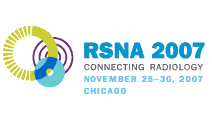
Abstract Archives of the RSNA, 2007
LL-BR2123-H04
New Quantitative Method in Breast Elastography: Fat Lesion Ratio (FLR)
Scientific Posters
Presented on November 27, 2007
Presented as part of LL-BR-H: Breast Imaging
Ei Ueno MD, PhD, Presenter: Research grant, Hitachi, Ltd
Takeshi Umemoto MD, Abstract Co-Author: Nothing to Disclose
Hiroko Bando MD, PhD, Abstract Co-Author: Nothing to Disclose
Eriko Tohno MD, Abstract Co-Author: Nothing to Disclose
Koji Waki MS, Abstract Co-Author: Research support, Hitachi, Ltd
Takeshi Matsumura MS, Abstract Co-Author: Employee, Hitachi, Ltd
In 2003, we completed the development of elastography which allows diagnosis by physicians even which little experience in ultrasound, and this technique has been commercialized and marketed since 2004. The performance of diagnosis with elastography is superior or equivalent to the conventional “B-mode diagnosis + color Doppler” modality, with high reliability. It has the additional advantage of being simple and convenient. However one of the issues was the lack of the objectivity in diagnosis based on strain imaging. In the next step we developed a new quantitative method: Fat-Lesion Ratio (FLR) which provides greater objectivity in assessing elastography (strain image).
FLR is defined as the ratio value obtained by dividing the mean strain at fat by the mean strain at hypo-echoic lesion. The strain for subcutaneous fat was determined from a circle bounded by the skin and mammary glands, and the strain for the lesion was determined from a circle bounded by the inner margin of the hypo-echoic area.
Subjects were 408 cases with hypo-echoic lesions not over 2cm in diameter who have been examined elastography from January 25 2005. Among these subjects were 135 cases of breast cancer (mean age 54.6 ± 11.1, lesion diameter 12.1 ± 4.4 mm) and 271 cases of benign disease (mean age 45.9 ± 10.6, lesion diameter 9.6 ± 4.1).
The mean value for FLR in breast cancer (14.8) was considerably higher than the mean value for FLR in benign disease (4.47). Using a cut-off point of 4.8, we obtained sensitivity of 76.6%, specificity of 76.8%, and accuracy of 76.7%. Area under the ROC curve was high (0.818), while those of B-mode are 85.9%, 84.1% and 84.7% respectively. Although the accuracy of FLR is lower than that of B-mode, it is significant that FLR alone provided highly reliable diagnostic accuracy.
It is concluded that FLR showed sufficient clinical performance with high diagnostic objectivity not depended on the experience of examiners.
Just with a short training for FLR method, non-specialized examiners can acquire the equivalent degree of competence for diagnosis as specialists in ultrasonic diagnosis for breast cancer.
Ueno, E,
Umemoto, T,
Bando, H,
Tohno, E,
Waki, K,
Matsumura, T,
New Quantitative Method in Breast Elastography: Fat Lesion Ratio (FLR). Radiological Society of North America 2007 Scientific Assembly and Annual Meeting, November 25 - November 30, 2007 ,Chicago IL.
http://archive.rsna.org/2007/5015476.html

